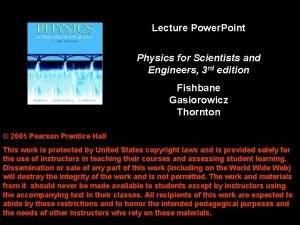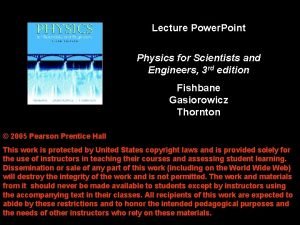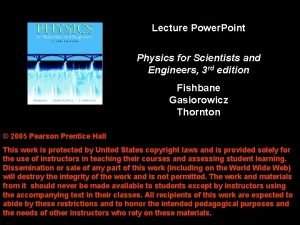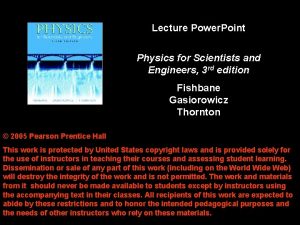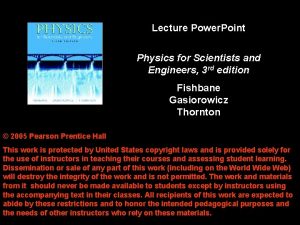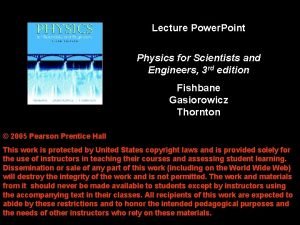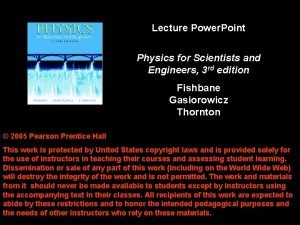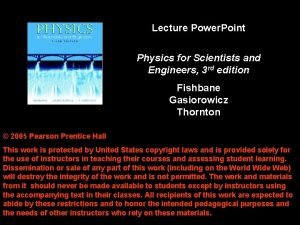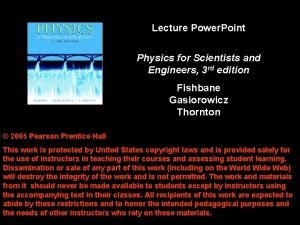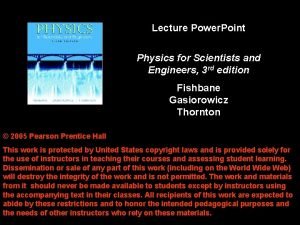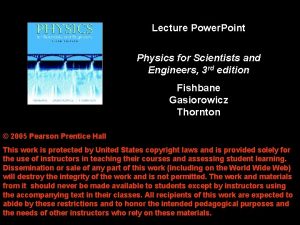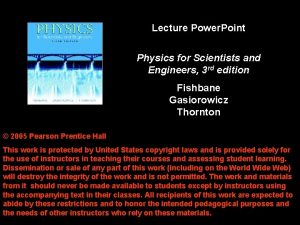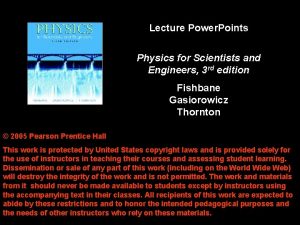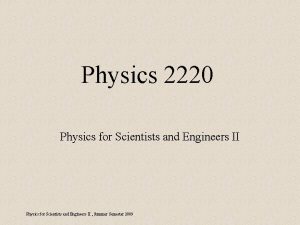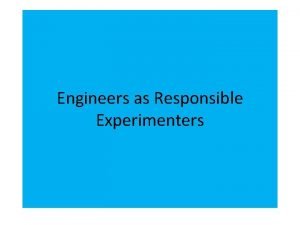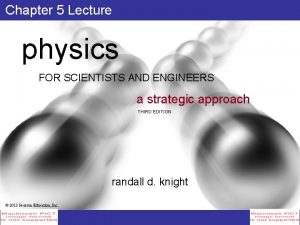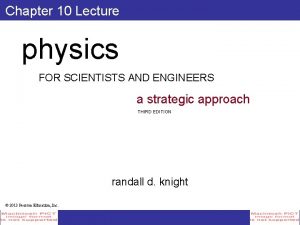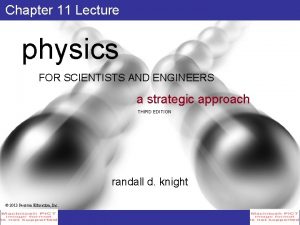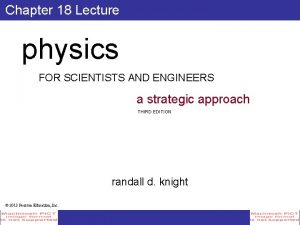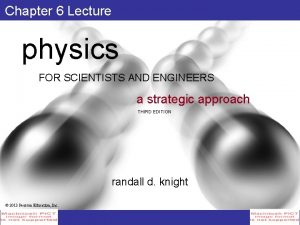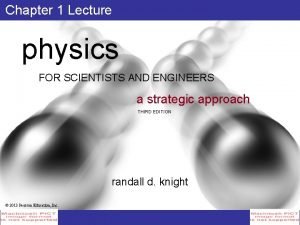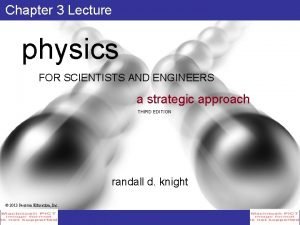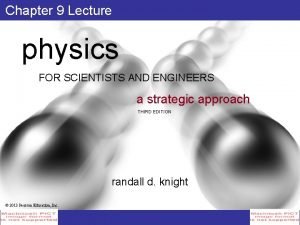Lecture Power Point Physics for Scientists and Engineers




























- Slides: 28

Lecture Power. Point Physics for Scientists and Engineers, 3 rd edition Fishbane Gasiorowicz Thornton © 2005 Pearson Prentice Hall This work is protected by United States copyright laws and is provided solely for the use of instructors in teaching their courses and assessing student learning. Dissemination or sale of any part of this work (including on the World Wide Web) will destroy the integrity of the work and is not permitted. The work and materials from it should never be made available to students except by instructors using the accompanying text in their classes. All recipients of this work are expected to abide by these restrictions and to honor the intended pedagogical purposes and the needs of other instructors who rely on these materials.

Chapter 22 Electric Field

Main Points of Chapter 22 • Electric field • Superposition • Electric dipole • Electric field lines • Field of a continuous distribution of charge • Motion of a charge in a field • Electric dipole in external electric field

22 -1 Electric Field Definition of electric field: force on small test charge, divided by the magnitude of the charge: (22 -1) Test charge must be small enough that it does not affect field:

22 -1 Electric Field More properly, the electric field is defined: (22 -2) Units of electric field: N/C (newtons per coulomb) For a point charge, the electric force is: (22 -3)

22 -1 Electric Field Therefore, the electric field of a point charge is: (22 -5) The field points outwards from a positive charge and inwards to a negative one:

22 -1 Electric Field Once the electric field is known, can immediately find the force on any point charge q′: (22 -7)

22 -1 Electric Field Since electric forces add by superposition, the electric field does as well. For a group of point charges: (22 -11)

22 -1 Electric Field An electric dipole is defined as equal and opposite charges a distance L apart: The electric dipole moment is defined as: (22 -13) and points from the negative charge towards the positive one.

22 -1 Electric Field The field of an electric dipole falls off faster than the field of a single point charge; it decreases as 1/r 3. Electric dipoles are often found in nature. Charged objects can induce electric dipoles (left); molecules may have permanent electric dipole moments due to their structure (right).

22 -2 Electric Field Lines Electric field lines are a useful aid to visualizing the electric field. There are two rules to drawing these lines: 1. The electric field is tangent to the field line at every point. 2. The density of electric field lines is an indicator of relative field strength. The next slide shows field lines for a point charge, including the decrease in density as one moves farther from the charge.

22 -2 Electric Field Lines Field lines of a positive point charge:

22 -2 Electric Field Lines Electric field lines have certain properties which should be carefully noted: 1. Lines can start or end only on charges. 2. The electric field lines of a point charge go off to infinity, and by superposition this will be true for any localized collection of charges with a net charge.

22 -2 Electric Field Lines Electric field lines have certain properties which should be carefully noted: 3. Electric field lines originate on, and run outward from, positive charges. They run toward, and terminate on, negative charges. 4. No two field lines ever cross, even when multiple charges are present.

22 -2 Electric Field Lines Left: two equal, same-sign charges Right: an electric dipole Important note: We always draw only a few sample field lines; otherwise the sketch would be solid color. There is electric field between all the lines in these two examples except for one point on the left-hand diagram.

22 -3 The Field of a Continuous Distribution To find the field of a continuous distribution of charge, treat it as a collection of near-point charges: (22 -17) Summing over the infinitesimal fields: (22 -18)

22 -3 The Field of a Continuous Distribution Finally, making the charges infinitesimally small and integrating rather than summing: (22 -20) Some types of charge distribution are relatively simple. Constant linear charge density : (22 -21) (22 -22)

22 -3 The Field of a Continuous Distribution Constant surface charge density (22 -24) : (22 -23)

22 -3 The Field of a Continuous Distribution Constant volume charge density (22 -26) : (22 -25)

22 -3 The Field of a Continuous Distribution From the electric field due to a uniform sheet of charge, we can calculate what would happen if we put two oppositely-charged sheets next to each other: The individual fields: The superposition: The result:

22 -4 Motion of a Charge in a Field While the electron is between the plates, it experiences an acceleration in the y-direction:

22 -4 Motion of a Charge in a Field Specifically, the acceleration is: (22 -38) The initial velocity is in the x-direction, so the velocity as a function of time is: (22 -39) The time taken by the charge to traverse the plates is determined only by the initial velocity.

22 -4 Motion of a Charge in a Field Therefore, the particle’s deflection in the ydirection is: (22 -42) It exits the field making an angle θ with its original direction, where: (22 -43)

22 -5 The Electric Dipole in an External Electric Field An electric dipole in a uniform electric field will experience no net force, but may experience a torque:

22 -5 The Electric Dipole in an External Electric Field The torque then is: (22 -44) Using the dipole moment: (22 -46) Work done by the field: (22 -47) Therefore the potential energy is: (22 -49) Which can also be written: (22 -50)

Summary of Chapter 22 • Electric field is defined as the force per unit charge: (22 -2) • Force on a point charge q′: (22 -7) • Electric field lines are very useful for visualizing the electric field, as long as their limitations are taken into account.

Summary of Chapter 22, cont. • Electric field of a point charge: (22 -5) • Electric fields obey the superposition principle. • Electric dipole: equal and opposite charges separated by a distance L. The electric field is proportional to the dipole moment, which is: (22 -13)

Summary of Chapter 22, cont. • An electric dipole in an external electric field feels a torque, and has potential energy: (22 -46) (22 -50) • Electric field due to a continuous charge distribution: (22 -20)
 01:640:244 lecture notes - lecture 15: plat, idah, farad
01:640:244 lecture notes - lecture 15: plat, idah, farad Power traiangle
Power traiangle Power bi training powerpoint
Power bi training powerpoint Point point power
Point point power Power system dynamics and stability lecture notes
Power system dynamics and stability lecture notes Power system dynamics and stability lecture notes
Power system dynamics and stability lecture notes Physics 111 lecture notes
Physics 111 lecture notes Physics 101 lecture notes pdf
Physics 101 lecture notes pdf Physics 101 lecture 1
Physics 101 lecture 1 Physics 101 lecture notes pdf
Physics 101 lecture notes pdf Pdf
Pdf Atmospheric physics lecture notes
Atmospheric physics lecture notes Zline 667-36
Zline 667-36 Power semiconductor devices lecture notes
Power semiconductor devices lecture notes Switch mode power supply lecture notes
Switch mode power supply lecture notes Things fall apart customs
Things fall apart customs Hub and spoke advantages and disadvantages
Hub and spoke advantages and disadvantages Sometimes scientists make a mistake or
Sometimes scientists make a mistake or Diagrams tables and graphs are used by scientists mainly to
Diagrams tables and graphs are used by scientists mainly to Why does it happen
Why does it happen University physics with modern physics fifteenth edition
University physics with modern physics fifteenth edition Physics ia introduction
Physics ia introduction Fspos vägledning för kontinuitetshantering
Fspos vägledning för kontinuitetshantering Novell typiska drag
Novell typiska drag Nationell inriktning för artificiell intelligens
Nationell inriktning för artificiell intelligens Ekologiskt fotavtryck
Ekologiskt fotavtryck Varför kallas perioden 1918-1939 för mellankrigstiden
Varför kallas perioden 1918-1939 för mellankrigstiden En lathund för arbete med kontinuitetshantering
En lathund för arbete med kontinuitetshantering Kassaregister ideell förening
Kassaregister ideell förening





























